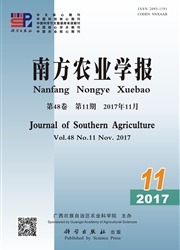

 中文摘要:
中文摘要:
【目的】通过农杆菌介导的遗传转化(ATMT)方法,建立香蕉枯萎病4号生理小种的高效转化体系,构建病原菌的突变体库并进行筛选,为已突变基因提供分子标记,在分子水平上对香蕉枯萎病菌的功能基因进行深入研究。【方法】通过单因子变量(试验材料、真菌孢子浓度、农杆菌预诱导终浓度、IM诱导培养基pH、共培养介质、共培养时AS浓度、共培养温度)试验,研究影响农杆菌介导的遗传转化效率的关键因素,并通过形态观察与致病性试验筛选突变体。【结果】得到的最佳转化条件为:农杆菌预诱导浓度OD600=0.8,病原菌孢子浓度106 CFU/mL,转化受体材料为分生孢子,共培养培养基pH 5.4,共培养温度25 ℃,共培养培养基中AS浓度200 μmol/L,共培养介质为硝酸纤维素膜。通过条件优化,转化效率可达到800-900个转化子/106个孢子。【结论】通过农杆菌介导的遗传转化成功将GFP基因转入病原菌中并表达,构建了病原菌的T-DNA插入突变体库,并通过筛选得到多个表型和致病性发生变化的突变体,为香蕉枯萎病菌基因组功能注释的研究奠定了基础。
 英文摘要:
英文摘要:
【Objective】Based on agrobacterium-mediated transformation(ATMT), Fusarium oxysporum f.sp.cubense race 4 effective transformation system was established and mutant database of pathogenic bacteria was constructed to provide molecular markers for mutant gene and further research on functional gene of Fusarium oxysporum f.sp.cubense. 【Method】In single factor variable experiment, testing material, fungal spore concentration, agrobacterium induction final concentration, IM induction medium pH, co-culture medium, co-culture AS concentration and co-culture temperature were studied to find out the key factors influencing transformation efficiency. Through morphologic observation and pathogenicity tests, mutants were screened. 【Result】The optimal conditions were A. tumefaciens(AGL1) induction concentration OD600=0.8, transformation receptor of 1×106 conidia/mL, co-culture at pH 5.4 and 25 ℃, co-culture AS concentration of 200 μmol/mL and co-culture medium of nitrocellulose membrane. Under the improved conditions, transformation efficiency was in the range of 800-900 transformants per 106 conidia. 【Conclusion】GFP was successfully inserted and expressed in pathogenic bacteria. T-DNA mutant database of pathogenic bacteria was built. Many pathogenicity and phenotype changing mutant was screened to provide references for Fusarium oxysporum f.sp.cubense genome function research.
 同期刊论文项目
同期刊论文项目
 同项目期刊论文
同项目期刊论文
 期刊信息
期刊信息
